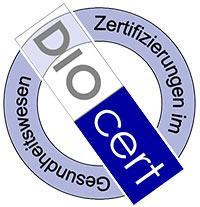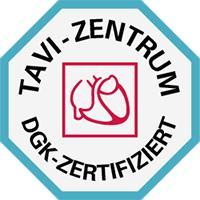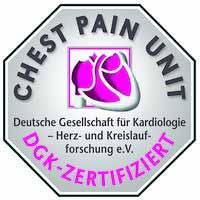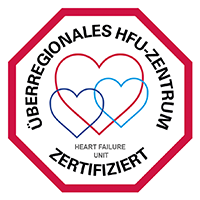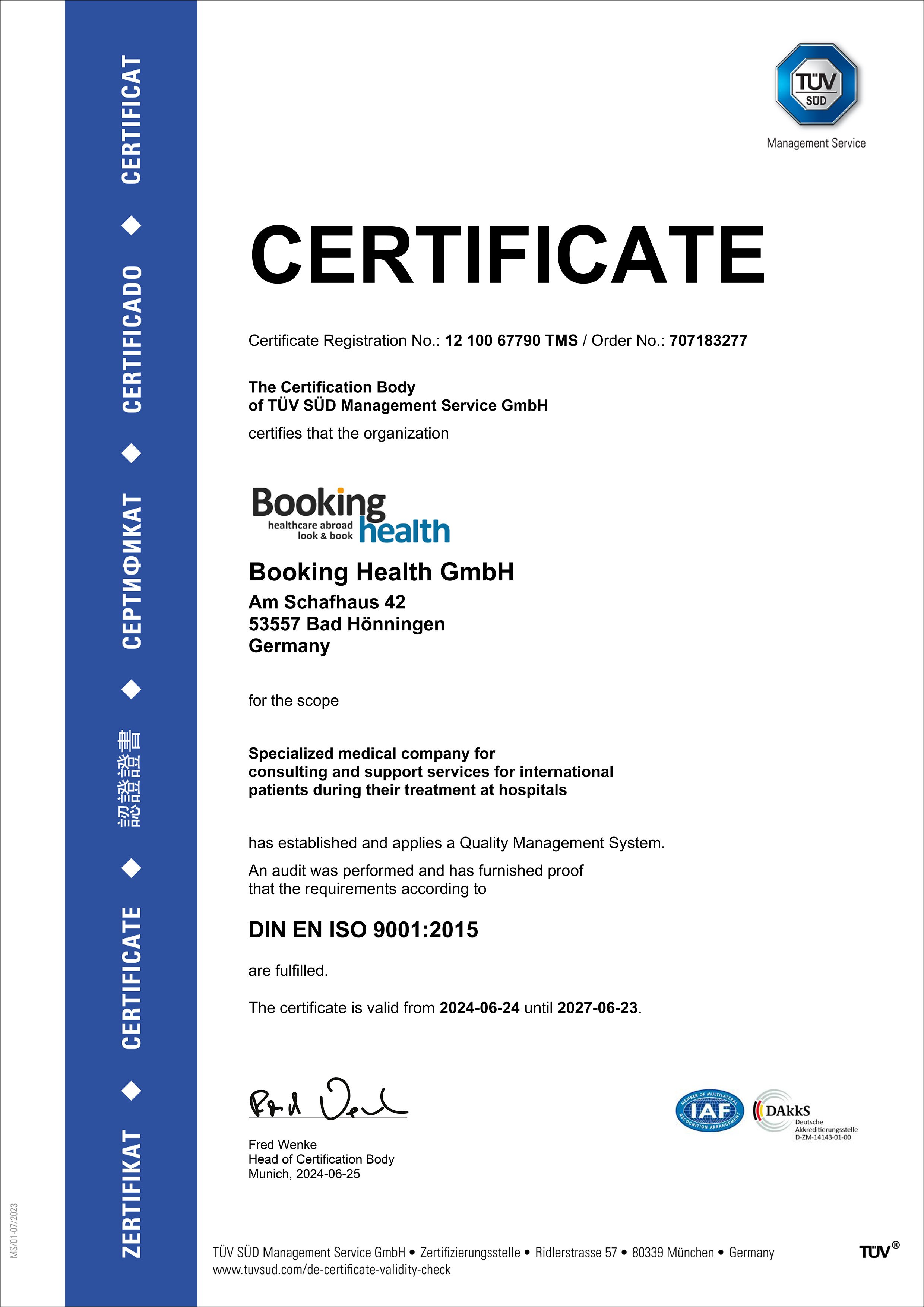The pericardium is the "bag" that surrounds the heart. It consists of two layers. Inflammation of the pericardium is called pericarditis. This disease is characterized by fluid accumulation between the two layers. The result of inflammation can be irreversible damage to the pericardium, fusion of its layers, scarring and deposition of calcium salts. Pericarditis treatment for most patients is conservative. The development of severe acute or chronic forms of the disease requires invasive procedures and surgery. Doctors in developed countries give preference to minimally invasive transcatheter and thoracoscopic interventions. Such treatment is associated with minimal trauma, rarely causes complications, and allows patients to recover quickly.
Content
- Causes
- Clinical course of pericarditis
- Symptoms
- Diagnostics
- Conservative treatment
- Surgical treatment
- Why is it worth undergoing treatment for pericarditis abroad
- Treatment in Europe at an affordable price
Causes
Pericarditis is classified by origin. The disease is divided into two large groups: infectious and non-infectious.
There are 7 variants of infectious pericarditis:
- Bacterial nonspecific.
- Specific (for example, developing due to syphilis, brucellosis, cholera).
- Tuberculous.
- Chlamydial.
- Rheumatic (autoimmune damage to the pericardium due to streptococcal infection of another localization).
- Viral (herpes, enterovirus, adenovirus).
- Casuistic (that is, very rare) – caused by amoebas, molds, parasites, etc.
The second large group is non-infectious or aseptic pericarditis. There are eight types of this pathology:
- Allergic and drug-induced (pericarditis is most often caused by cytostatics, antiarrhythmic drugs and antibiotics).
- Autoimmune.
- Traumatic (including due to surgery, electric shock, etc.);
- Developing against the background of systemic connective tissue diseases;
- Developing against the background of blood diseases.
- Developing due to oncological pathologies;
- Associated with metabolic disorders (endocrine disorders, liver or kidney failure, gout);
- Idiopathic (of unknown origin).
Clinical course of pericarditis
The pericardial diseases are not common European diseases. In the developed countries of Europe, this pathology accounts for only 0.2% of all reasons for hospitalization. The real prevalence of the pathology is higher than the number of diagnoses, but the disease often proceeds with mild symptoms, so patients do not always seek medical help.
In countries with poorly developed medicine, tuberculosis predominates among the causes of pericarditis. It accounts for up to 70% of all diagnoses. The mortality rate in this type of pericarditis is very high: it reaches 40%.
In developed countries, viral or non-infectious pericarditis is more common. Mortality rate in the acute form of the disease is about 1%.
Acute bacterial pericarditis caused by Staphylococcus aureus is characterized by the worst prognosis. Mortality rate in case of this pathology reaches 75-80%. Nonetheless, it occurs infrequently: about 1% of all types of pericarditis.
According to the clinical course, pericarditis can be:
- Acute – resolves within 4 weeks.
- Chronic – lasts more than 3 months.
After the treatment of acute pericarditis, three quarters of patients are cured once and for all. However, in 25% of cases, relapses occur. In some patients, the disease becomes chronic. The advancement to chronic fibrinous or constrictive pericarditis is considered an unfavorable outcome of the pathology. Its likelihood differs depending on the origin of the disease. With viral pericarditis, 1% of cases of pathology progress into the fibrinous form, with autoimmune pericarditis – 5%, with a bacterial infection – 30%. This is a consequence of damage to the pericardium with the formation of scar tissue followed by the deposition of calcium salts.
There are four types of chronic pericarditis. These types can also be called stages, since they successively replace each other with the progression of the disease:
- Exudative (with liquid inside).
- Adhesive – the formation of adhesions between the layers of the pericardium, as well as between the pericardium and adjacent organs, but these adhesions do not interfere with cardiac activity.
- Constrictive – the formation of adhesions and scars that disrupt cardiac activity.
- Armored heart – a manifestation of advanced constrictive pericarditis, this is the hardening of the pericardium due to the deposition of calcium salts.
Even in the most severe cases, treatment for pericarditis can be successful. But if the pericardium is irreversibly damaged, doctors have to remove it during surgery. After such treatment, the 20-year survival rate of patients averages 75%, and in countries with advanced medicine, it exceeds 85%.
Symptoms
The dominant symptom of pericarditis is pain in the area of the heart. It is associated with movement, and can be intensified by coughing and deep inhalation. The pain is usually constant, of moderate intensity. It weakens or disappears with the patient sitting forward.
Other clinical manifestations occur in the case of cardiac tamponade, if too much fluid accumulates around the heart. In this case, a person may experience symptoms that resemble heart failure. The person's heart rate increases, shortness of breath, cough, weakness appear, and blood pressure decreases.
The development of cardiac tamponade results in the classic triad of signs, known as the Beck's triad:
- Low blood pressure.
- Muffled heart sounds on auscultation.
- Elevated jugular venous pressure.
All classic symptoms manifest themselves only in case of severe pericarditis with rapid fluid accumulation. In this event, when examining the patient, the doctor can see swollen jugular veins in the neck. The patient may also have pain in the right hypochondrium due to stagnation of venous blood in the liver.
Another classic manifestation of cardiac tamponade is pulsus paradoxus. It is weak when inhaling and becomes stronger when exhaling. When measuring blood pressure, a medical specialist can find that when inhaling it is 10 mmHg or more lower than when exhaling.
Diagnostics
To establish a diagnosis of acute pericarditis, three out of four criteria are required:
- Pain in the area of the heart.
- Pericardial friction rub that can be heard with a phonendoscope.
- Characteristic changes in the electrocardiogram.
- Detection of pericardial effusion using instrumental diagnostic methods.
Echocardiography (ultrasound of the heart) is most commonly used for heart imaging. The doctor can detect the effusion, evaluate its effect on hemodynamics, and measure the "thickness" of the effusion.
A CT scan and MRI of the heart are more accurate diagnostic tests. They are used less often, only if echocardiography was not informative enough.
In countries with poorly developed medicine, chest x-rays are still used for heart imaging. Nevertheless, this examination is informative only in case of the development of cardiac tamponade with accumulation of at least 300 ml of exudate.
To determine the causes of pericarditis, laboratory diagnosis is used. Doctors carry out tests for infections and antibodies that can damage the heart due to the presence of autoimmune pathologies. General clinical examinations are carried out to assess the function of the liver, kidneys and other internal organs.
Conservative treatment
Pericarditis is not always severe. Sometimes the effusion around the heart is slow and small. In this case, the effect on hemodynamics is minimal.
The treatment mostly involves the use of conservative therapy. Doctors prescribe nonsteroidal anti-inflammatory drugs. Anti-inflammatory drugs of other pharmacological groups are less commonly used. These can be corticosteroids and colchicine. Doctors in developed countries also treat patients with interleukin-1 receptor antagonists.
Therapy is also aimed at eliminating the cause of pericarditis, if it was possible to establish it, and if this cause must be eliminated. For example, bacterial pericarditis requires long-term antibiotic therapy. In case of inflammation of the pericardial sac of herpes origin, doctors use acyclic nucleosides that suppress the replication of the virus.
Surgical treatment
Severe cases of the pathology cause a very quick accumulation of fluid in the pericardial cavity, which results in the development of cardiac tamponade. The heart cannot contract normally, as it is compressed from the outside by the liquid. In such situations, emergency surgery or invasive procedures are performed.
To remove the contents of the pericardial cavity, the following methods can be used:
- Pericardiocentesis.
- Intrapericardial thrombolysis.
- Surgical drainage.
- Long-term drainage, which is required in case of constant accumulation of fluid in the pericardial cavity.
Pericardiocentesis is the pumping of fluid from the pericardial cavity with a thick needle. In developed countries, this procedure is safe, and therefore it very rarely leads to complications. The doctor inserts the needle under the guidance of ultrasound or computed tomography.
Intrapericardial thrombolysis is a single-stage procedure. The doctor injects fluid into the pericardial cavity, which dissolves blood clots. The medical specialist may additionally administer anti-inflammatory drugs, antibiotics, and other medications.
Surgical drainage of the pericardium is rarely used. It is required in cases where the fluid located inside the pericardial cavity is too thick and cannot be pumped out with a needle. For example, pus has accumulated around the heart due to bacterial pericarditis or blood clots have appeared. In addition, after trauma or due to some congenital anomalies, the anatomical features of the chest can become an obstacle to pericardiocentesis. In such situations, patients also require a surgical intervention.
Long-term drainage is used for severe pericarditis, when more than 1 liter of fluid accumulates in the pericardial cavity. It continues in parallel with the treatment aimed at eliminating inflammation. The drainage is stopped after the volume of fluid released per day decreases to 30 ml. This procedure makes the treatment of pericarditis more effective. It reduces the risk of recurrence of cardiac tamponade by 5 times within the next 12 months.
Even without cardiac tamponade, pericarditis can become chronic. Gradually, the pericardial sac thickens, thickens and becomes scarred. Then calcium salts are deposited on it. Some patients develop constrictive pericarditis, which leads to chronic pain.
Here are some of the surgical treatment options for chronic pericarditis:
A pericardial "window" is the formation of the outflow tract to direct fluid from the pericardial sac into the pleural cavity. This surgery is required for the malignant course of pericarditis, characterized by the constant fluid accumulation.
Doctors in developed countries of Europe use minimally invasive methods for performing this surgery:
- Thoracoscopy, which is the surgery performed through short incisions in the chest, using video endoscopic equipment.
- Balloon pericardiotomy is a surgical procedure with the insertion of a balloon catheter through a needle, which is then inflated, thereby dilating the opening in the pericardium.
Pericardiectomy is a radical treatment method that involves the removal of damaged parts of the pericardium. Another name for this surgery is cardiac decortication. This is an open surgical procedure that requires a sternotomy (a large incision in the center of the sternum). Pericardiectomy is used in cases where the pericardium is irreversibly damaged, and other treatment methods are futile.
Why is it worth undergoing treatment for pericarditis abroad
Any heart disease, even the most severe one, can be successfully treated abroad. Timely high-quality therapy allows curing acute pericarditis, preventing it from becoming chronic. Even in the advanced stage of the disease, modern drug therapy regimens and minimally invasive interventions make it possible to get rid of chest pain and eliminate effusion in the pericardial sac.
There are several reasons for you to undergo treatment in one of the countries with advanced health care system:
- High-precision diagnosis allows determining the origin and mechanism of development of pericarditis.
- Therapy is aimed at eliminating the cause of the disease.
- Most types of acute pericarditis can be completely cured without the use of invasive procedures and surgical interventions.
- Successful treatment of even severe forms of bacterial pericarditis.
- Most patients undergo minimally invasive procedures to remove effusion instead of surgery.
- The use of minimally invasive thoracoscopic interventions or balloon pericardiotomy in order to form the outflow tract for pericardial effusion.
Treatment in Europe at an affordable price
To undergo treatment in one of the European hospitals, you can use the services of the specialists working in Booking Health. On our website, you can find out the cost of treatment in Europe, compare prices and book a medical care program at a favorable price. The treatment in Europe will be easier and faster for you, and the cost of treatment will be significantly lower.
You are welcome to leave your request on the Booking Health website. Our medical advisor will contact you within 24 hours. The medical tourism operator from the Booking Health company will take care of the organization of your trip for medical treatment in Europe. We will provide the following benefits for you:
- We will choose a hospital for treatment in Europe, whose doctors specialize in the treatment of pericarditis and achieve the best results.
- We will help you overcome the language barrier and establish communication with your attending physician.
- We will reduce the waiting time for the medical care program. You will receive medical services on the most suitable dates.
- We will reduce the price. The cost of treatment in a European hospital will be lower due to the lack of overpricing and additional coefficients for foreign patients.
- We will solve all organizational issues, such as paperwork, hotel booking, transfer from the airport to the hospital. An interpreter will accompany you abroad.
- We will prepare a program and translate medical documents. You will not have to repeat the previously performed diagnostic procedures.
- We will keep in touch with the hospital after treatment in Europe.
- We will organize additional diagnostic examinations and treatment in a European hospital, if required.
- We will buy medicines abroad and forward them to your native country.
The best specialists in the world will take care of your health. The Booking Health employees will help to reduce the cost of treatment, organize the trip, and you will be able to fully focus on restoring your health.
Authors: Dr. Vadim Zhiliuk, Dr. Sergey Pashchenko




